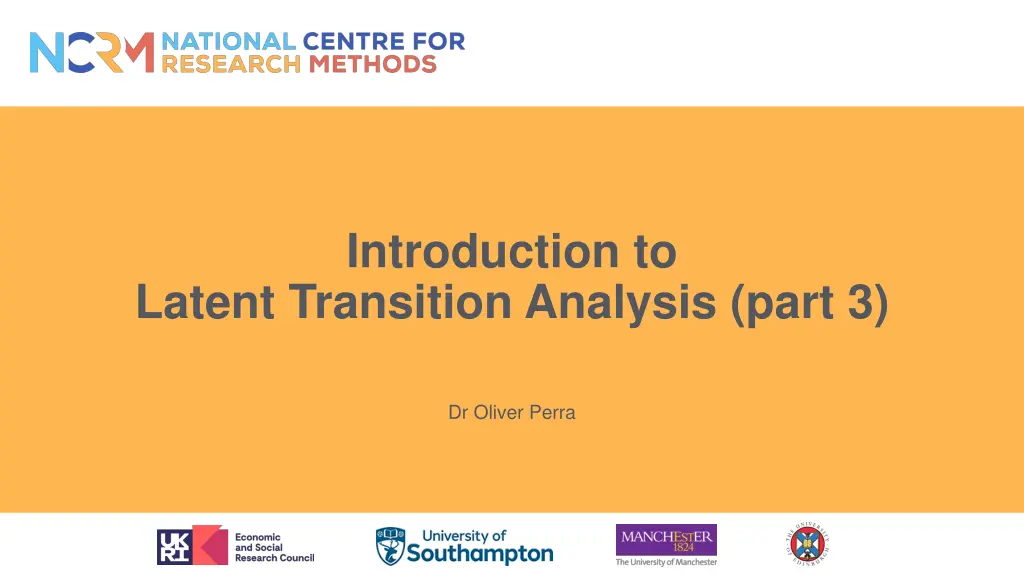
Advancing Latent Transition Analysis: Models and Applications
Discover the intricacies of Latent Transition Analysis (LTA) through a detailed exploration of its stages, including the measurement model at each time point, continuity and discontinuity in observed behaviors, and the use of a 3-step approach for structural modeling. Learn about investigating transition probabilities, models with covariates and distal outcomes, and how to impose relationships between different classes. Dive into the world of LTA with practical and substantive advantages highlighted for a better understanding of this analytical technique.
Download Presentation

Please find below an Image/Link to download the presentation.
The content on the website is provided AS IS for your information and personal use only. It may not be sold, licensed, or shared on other websites without obtaining consent from the author. If you encounter any issues during the download, it is possible that the publisher has removed the file from their server.
You are allowed to download the files provided on this website for personal or commercial use, subject to the condition that they are used lawfully. All files are the property of their respective owners.
The content on the website is provided AS IS for your information and personal use only. It may not be sold, licensed, or shared on other websites without obtaining consent from the author.
E N D
Presentation Transcript
Introduction to Latent Transition Analysis (part 3) Dr Oliver Perra
Summary: Latent Transition Analysis (LTA) Measurement model at each time point: Observed behaviours are causally related to underlying categorical differences; Continuity: Formal tests of measurement invariance; Discontinuity: New categories may emerge at different time points. Structural model: Use 3-step approach to allow for measurement model uncertainty: Substantive advantages: Measurement model estimation separated from structural model one. Practical advantages: Less computational costs, easier to estimate more complex models.
Stages of LTA https://doi.org/10.4135/9781526421036878157 Stage 1 LCA solutions to data at different time points; Stage 2 Explore measurement invariance; Stage 3 Extract latent classes parameters; Stage 4 Model structural relations across time Stage 5 Include covariates as predictors of latent classes across time Stage 6 Include distal outcomes.
Outline Investigate transition probabilities Models with covariates and distal outcomes Models with moderation Associative Latent Transition models
Investigate Transition Probabilities
Step 3: Impose relationships between different classes, while controlling for measurement error in class assignment
Step 3: Impose relationships between different classes, while controlling for measurement error in class assignment
Transition Probabilities . Age 14 / Age15 Abusers Experim. Abstain. Total Experim. Abstain. 0.39 0.07 0.56 0.25 0.05 0.68 1.00 1.00
Transition Probabilities . Age 14 / Age15 Abusers Experim. Abstain. Total Experim. Abstain. 0.39 0.07 0.56 0.25 0.05 0.68 1.00 1.00 Continuity
Constraints on Transition Probabilities Age 14 / Age15 Abusers Experim. Abstain. Total . Experim. Abstain. 0.39 0.07 0.56 0.25 0.05 0.68 1.00 1.00
Constraints on Transition Probabilities Age 14 / Age15 Abusers Experim. Abstain. Total . Experim. Abstain. 0.39 0.07 0.56 0.25 0.05 0.68 1.00 1.00 Age 14 / Age15 Abusers Experim. Abstain. Tot. Experim. Abstain. 0.40 0.07 0.60 0.25 0.00 0.68 1.00 1.00 Model with constrained probability nested within model with free transition probabilities: Use Likelihood-Ratio Test (LRT) to test H0 of no difference in fit between models.
Transition Probabilities: No back-sliding Time 0 / Time 1 Novice Learner Master Total . Novice Learner Master pn_t1|n_t0 0 0 pl_t1|n_t0 pl_t1|l_t0 0 pm_t1|n_t0 pm_t1|l_t0 pm_t1|m_t0 1.00 1.00 1.00
Model structural relations across time Model structural relations across time LTA is an autoregressive model: one status directly related to previously status. First order effects (Classes t0 Classes t1) ; Classes t0 Classes t1 Classes t2 @ @ @ E_cl_t1 E_cl_t2 E_cl_t0
Model structural relations across time Model structural relations across time LTA is an autoregressive model: one status directly related to previously status. First order effects (Classes t0 Classes t1) ; Second order effects (Classes t0 classes t2). Classes t0 Classes t1 Classes t2 @ @ @ E_cl_t1 E_cl_t2 E_cl_t0
Include covariates and distal outcomes
Include Covariates Include Covariates Gender
Include Covariates Include Covariates Gender Parameters Age 14: pclass_14|gender Parameters Age 15: pclass_15|gender & class_14
Include covariates Females t0 / t1 Users Non Users Users 0.40 0.60 Non Users 0.28 0.72 Males t0 / t1 Users Non Users Users 0.51 0.49 Non Users 0.38 0.62
Include covariates Females t0 / t1 Users Abstainers Users 0.40 0.60 Abstainers 0.28 0.72 Males t0 / t1 Users Abstainers Users 0.51 0.49 Abstainers 0.38 0.62 Males: Odds of User@t1 | Abstainers@t0 = .38 .62 = 0.61 Females: Odds of User@t1 | Abstainers@t0 = .28 .72 = 0.39 Odds Ratios of becoming User for Males compared to Females: 0.61 0.39 = 1.56
Include covariates Females Probability of being User @t1 t0 / t1 Users Abstainers 0.6 Users 0.40 0.60 0.5 Non Users 0.28 0.72 0.4 Males 0.3 t0 / t1 Users Abstainers Users 0.51 0.49 0.2 Non Users 0.38 0.62 0.1 0 User @t0 Abstainer @t0 Females Males
Moderation Moderation Gender
Moderation Moderation Females Probability of being User @t1 t0 / t1 Users Abstainers 0.6 Users 0.40 0.60 0.5 Abstainers 0.29 0.71 0.4 Males t0 / t1 Users Abstainers 0.3 Users 0.35 0.65 0.2 Abstainers 0.44 0.56 0.1 0 User @t0 Abstainer @t0 Females Males
Include Distal Outcomes Include Distal Outcomes Gender Age 16 School Attain ment
Associative LTA Associative LTA Depression Substance Use
Associative LTA: Cross Associative LTA: Cross- -Lagged Model Lagged Model Depression Substance Use
Summary Investigate Transition Probabilities E.g.: No backsliding ? Include covariates Investigate moderation effects Include distal outcomes More complex models: Associative LTA
